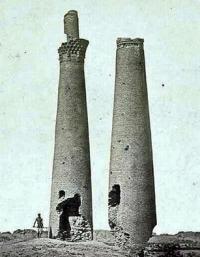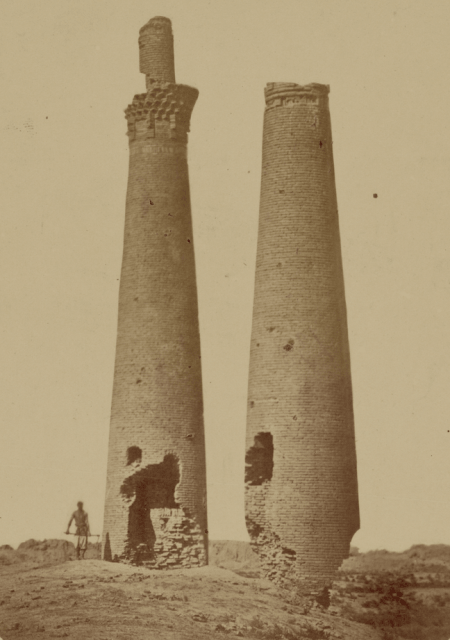Вы здесь
Minarets of Sauran.

Tours to the monuments of Kazakhstan.
“Two high minarets of extraordinary height and extreme nobility were placed on the shoulders of aivan. A chain is attached to the guldast of those minarets, and a log (forelock) is attached under the domes (kubba) of each minaret so that someone forces the log to move, the chain hesitates, and to the one in the opposite minaret, it seems that the minaret will collapse , and this is one of the wonders of the world"
Persian historian Wasifi. 1514 - 1515.
Monuments of culture of Kazakhstan.
This photograph of the ruins of the town of Sauran, located in the southern part of modern Kazakhstan, is contained in the archaeological part of Turkestan Album. A six-volume photographic study was prepared and published in 1871 - 1872. under the patronage of General Konstantin P. von Kaufman, the first Governor-General (1867 - 1882) of Turkestan, as the territory of Central Asia belonging to the Russian Empire was called at that time.
The title indicates that the photograph was taken in 1866, that is, earlier than photographs taken specifically for the album. Sauran (also known as Savran) was located at a distance of about 40 kilometers from the city of Yasy (modern Turkestan, Kazakhstan) and was considered an important point on the Great Silk Road.
In the XIV century, it became the capital of the local Ak-Horde (White Horde) and at that time was famous for the manufacture of ceramic tiles. ("Ak" means "white", and in traditional Turkic names of the main cardinal points corresponds to "south"; other main directions were "Kok", which means "blue" or "east"; "Dogwood" - "red" or "west"; and" Kara" - "black "or" north").
Brick minarets on a hilly area in the photo show signs of serious damage, but they still stand.
It seems that especially the right tower does not have enough ground. The outer wall of the tower is actually a shell, inside which there is a spiral staircase, but the center of the tower remains relatively intact. The tower on the left has a superstructure towering above the stalactite top of the main rod.
The figure on the left gives an idea of the scale of the towers. Minarets of Sauran. 1866 photo of Priorov. Here is what the Persian historian Vasifi, who lived for several years in this Syr Darya city in the 16th century, writes:
“On the shoulders of his aivan there are two minarets of extraordinary height and extreme nobility. A log is attached under the dome of each minaret so that if someone forces the log to move, the chain hesitates, and to the one on the opposite minaret it seems that the minaret will collapse."
One of the first researchers of Sauran, a member of the Imperial Archaeological Society, Petr Ivanovich Lerkh, excavated at the foot of some burnt brick towers. One of them still rose seven fathoms to a height, and the other collapsed either in 1867 or in 1878.

Authority:
"Religious and spiritual monuments of Central Asia." Author M. Khashimov. Saga Publishing House, 2001. 2004. www.farsah.kz. "Ancient Kazakhstan" Arias, Saki, Huns, Turks. Children's Encyclopedia of Kazakhstan. Almaty, 2007, Aruna Publishing House.







